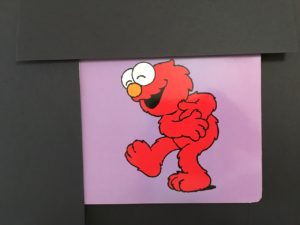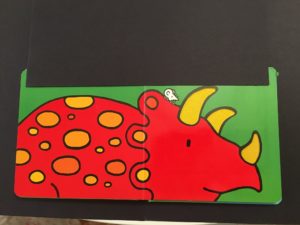
We’ve previously shared a list of books that we recommend for children with CVI because they are visually simple and include highly saturated colors. A couple of issues with books are that two dimensional images are more difficult to visually process than three-dimensional objects, and even simple books can sometimes be too visually busy, making them harder to see for kids with CVI.
CVI teacher Ellen Mazel offers these ideas for reducing visual complexity in board books. The main idea is to cover the unnecessary visual complexity with black fabric or paper to maximize simplicity. The focal point on the page then stands out more because any extraneous visual elements are removed from the forefront by a solid black cover. As time goes on, these covers can be removed as the child becomes more familiar with the book and able to tolerate more complexity.
Here is an example of this strategy with the book So Big!
Before:

And after:


You can see how these already simple images were made even clearer and less busy so that the visual contrast stands out more. Here’s another example from the book That’s Not My Dinosaur:

In these examples, we used solid black construction paper to offer a black background and cover up the text on the page. The example from Ellen Mazel’s post uses black felt. Get creative and find what works for you and your child. For added effect, consider matching a book with a preferred auditory event, such as pairing a picture of a cow with a “moo.”
Another way to incorporate a plain black background behind simple, CVI-friendly images is to use My Talking Picture Board, which offers much more flexibility in presentation than printed books. In addition, you can incrementally add more complexity to the imagery or the background or both as the child progresses in visual development. The images in My Talking Picture Board also offer a reward when touched, such as a movement, sound (including a voice-recording if you choose), or both. This interactive process will help the child learn the aspects of vision that he or she will use when they start to look at books. And remember, for printed books or digital media, start with simpler images before progressing to more complex images or backgrounds.
When you are ready to try more and more books with a child with CVI, here are some tips based on experiences from the Little Bear Sees Facebook community:
- Look for books with large simple, bright illustrations, easy text and relatable characters, like Leslie Patricelli’s books, for example.
- Try a variety of textured books.
- Incorporate a matching stuffed animal or doll if there is one available.
- Find books about things you already know the child likes.
- Present the book in the appropriate field of vision for the individual child (right, left, high or low), and encourage educators at school to do the same.
- Pay attention to what’s distracting behind the book, for example a bright window, a busy pattern on your shirt, etc.
Here are four additional tips from the West Virginia Department of Education for when a child is ready to look at pictures:
- Use pictures or simple books that have one object on a page with a plain background.
- Gradually add detail to the picture and ask the child to use the salient features to find specified items. (We recently posted about how to utilize salient features here).
- Take pictures of familiar people and toys or other items to make a simple picture book yourself (but be sure the pictures have a plain background).
- You may need to periodically go back to older, easier supports to give the child’s visual system a boost.
They also offer tips and ideas specific to CVI Phase III in this PowerPoint.
Since the strategy outlined here can be adapted to different tolerance levels of visual complexity, hopefully you found something helpful for your individual child wherever he or she is on the CVI range. Please share this with others who may find it helpful too, and let us know about your own experiences working with books and two-dimensional pictures in the comments or on our Facebook page.
Leave a Reply